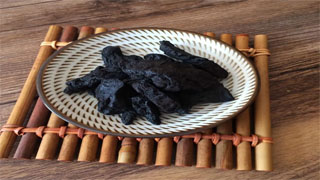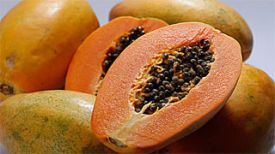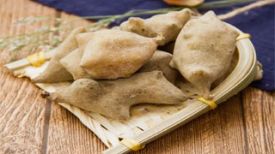
1. Aliases
Mature land.
2. Plant morphology
Perennial herbaceous plant, 10-70 centimeters tall. The entire plant is covered with grayish white long soft hairs and glandular hairs. The roots are thick, fleshy, block shaped, cylindrical or spindle shaped. The stem is upright, with a single or basal part bearing several branches. Basal leaves are clustered, with inverted ovate lanceolate leaves, blunt at the apex, gradually narrowing at the base, and extending downwards into a long petiole. The leaf surface is wrinkled, and the edges are irregularly serrated; The stem and leaves are smaller. The flower stem is upright, covered with hairs, and forms a raceme at the upper part of the stem; Bracts leafy, developed or degraded; Calyx campanulate, apex 5-lobed, lobes triangular, covered with villous and white hairs, with 10 veins; The corolla is wide and tubular, slightly curved, with a dark purple outside and yellow inside, with obvious purple stripes. The apex is 5-lobed and slightly two lipped; Stamens 4, 2-strong, anther base forked; Ovary superior, ovate, 2-loculed, 1-loculed after flowering, style 1, stigma enlarged. The capsule is ovoid or long ovoid, with a pointed tip and a persistent style, surrounded by a persistent calyx. Most seeds. The flowering period is from April to May, and the fruiting period is from May to June.
3. Origin distribution
Most regions in the country produce a large amount of real estate, with good quality in counties such as Wen County, Boai, and Meng County in Henan Province.
4. Harvesting and processing
(1) Take raw Rehmannia glutinosa and stew it with wine until the wine is completely absorbed. Take it out and let it dry until the outer skin and mucus are slightly dry. Cut it into thick slices or pieces and let it dry to obtain. For every 100 kilograms of raw rehmannia, 20-30 kilograms of yellow wine are used. (Wine stewing method: Take the product to be processed according to the regulations of each variety, add it to the wine, place it in a suitable container, seal it, heat it over water or steam, or stew until the wine is completely absorbed, let it cool, take it out, let it air dry until 60% dry, slice it, and dry. Generally, for every 100 kilograms of product to be processed, 20-30 kilograms of wine are used.)
(2) Take raw Rehmannia glutinosa, steam it according to the steaming method until it turns black and moist, take it out, sun it until it is about 80% dry, cut it into thick slices or pieces, and dry to obtain it. (Steaming method: Take the product to be roasted, divide it into different sizes, mix it well with water or liquid additives according to the regulations of each variety, moisten it thoroughly, place it in a suitable steaming container, heat it with steam to the specified degree, take it out, let it air slightly, mix back with the steaming liquid, and then air it until it reaches sixty thousand, slice or segment it, and dry.)
5. Characteristics of medicinal herbs
This product appears in irregular pieces and fragments, with varying sizes and thicknesses. The surface is dark black, glossy, and has high viscosity. Soft and resilient in texture, not easily broken, with a glossy black cross-section. Mild in flavor and sweet in taste.
6. Nature, taste, and meridian tropism
Mild in nature and sweet in taste. Return to the liver and kidney meridians.
7. Effect and function
Nourishing blood and yin, nourishing essence and filling marrow. Blood tonifying drugs classified under the category of tonifying deficiency drugs.
8. Clinical applications
Internal administration: Dosage of 10-30 grams, either in pills, powder, ointment, or soaked in alcohol. Used for blood deficiency and yellowing, palpitations and palpitations, menstrual disorders, blood leakage, liver and kidney yin deficiency, waist and knee soreness and weakness, bone steaming and hot flashes, night sweats and nocturnal emissions, internal heat and thirst quenching, dizziness, tinnitus, and premature whitening of hair.
9. Pharmacological research
A comparative study of the pharmacological effects of Rehmannia glutinosa and Rehmannia glutinosa on intravascular thrombosis syndrome shows that Chinese made pig bile like crude Rehmannia glutinosa can strongly inhibit hepatic hemorrhagic necrosis and simple necrosis. However, the effect of Rehmannia glutinosa on antithrombin is relatively weak. Using the fibrin plate method to explore the activation effect of fibrinogen on the fibrinolytic system, it was found that mature ground has an activation effect, while raw ground does not. There are also reports suggesting that both pre - and post carbonization effects of Rehmannia glutinosa have hemostatic effects, and the hemostatic effect of Rehmannia glutinosa after carbonization has not been enhanced. There was no significant difference in the hemostatic effect of the decoction of raw Rehmannia glutinosa, cooked Rehmannia glutinosa, raw Rehmannia charcoal, and cooked Rehmannia glutinosa charcoal.
10. Chemical composition
There are more water and alcohol extracts of various cooked Rehmannia than raw and dry Rehmannia, but the differences in water or alcohol extracts of cooked Rehmannia processed by various methods are not significant. The unique iridoid terpenes and iridoid glycosides in dried Rehmannia glutinosa are almost absent in ripe Rehmannia glutinosa. Rehmannia glutinosa contains 8.57% glucose, which is higher than that in fresh Rehmannia glutinosa (1.56%), indicating that after processing, some polysaccharides in Rehmannia glutinosa are converted into monosaccharides. During the processing of dried and cooked Rehmannia glutinosa, glycoside components also undergo varying degrees of decomposition, with monosaccharide glycosides being the most degraded, followed by disaccharide glycosides. Rehmannioside D, which contains three glycosides, hardly decomposes, while cooked Rehmannia glutinosa, except for catalpol, decomposes less than dried Rehmannia glutinosa. The difference between the two is not significant.
11. Taboos for use
Those with weak spleen and stomach, stagnation of qi and phlegm, and full and loose stools should not take it.
12. Compatibility prescription
① Treatment for impotence: 30g of cooked Rehmannia glutinosa, 12g of Cornus officinalis meat, 12g of stir fried Atractylodes macrocephala, 3g each of Polygala, Morinda officinalis, and Eucommia ulmoides, 6g each of Cinnamomum cassia and Poria miltiorrhiza, 9g each of Ginseng (stewed separately) and Goji berries, 15g each of Snake Bed Seed and Cistanche deserticola, 10g of Astragalus membranaceus, 20g each of Placenta powder and Xianling spleen (swallowed). If the disease progresses for a long time (with impotence lasting for more than 3 years), 1.5 grams of deer antler powder (diluted separately) or 10 grams of deer antler gel (diluted in Yanghua) should be added for 10 days as a course of treatment. Rest for one week and continue the second course of treatment Shanxi Traditional Chinese Medicine 1990; 6 (3): 16]
② Treatment for elderly constipation: 30 grams each of Rehmannia glutinosa, Angelica sinensis, Weilingxian, Atractylodes macrocephala, and Polygonum multiflorum, and 10 grams each of Cimicifuga. Boiled in water, 1 dose per day Inner Mongolia Traditional Chinese Medicine 1991; (3) 15]
③ Treatment for alopecia areata: 60 grams each of Rehmannia glutinosa and Dodder seed, 30 grams each of Angelica sinensis, Chuanxiong, and Hangshao, and 24 grams each of Papaya, Tianma, and Qianghuo. A total of finely ground ingredients were added, and 586 grams of honey were added as pills. Each dose was 10 grams, taken twice a day. Adding washing medicine to treat alopecia areata has a good therapeutic effect Journal of Traditional Chinese Medicine 1963; (7) : 14]
The content of the article is for clinical reference only. Non professionals in traditional Chinese medicine are not allowed to try medication.


